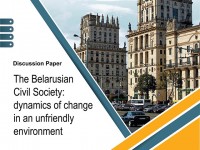Centre for European Transformation has conducted the third comprehensive study in form of monitoring of the implementation of the UNESCO Convention on the Protection and Promotion of the Diversity of Cultural Expressions by the Republic of Belarus.
Concept ideas on further development of Eastern Partnership Civil Society Forum (Policy Paper)

This document presents proposals of the Centre for European Transformation related to further development of EaP Civil Society Forum.
We consider the Forum as both catalyst and tool for implementing Europeisation and democratization processes in Belarus and development of civil society. Assessing positively results of last year work we nevertheless understand that without working out the concept of further CSF development efficient joint efforts in this field would be hardly possible.
Background and aims orientation of EaP Civil Society Forum
Development of EaP Civil Society Forum is determined by the following frame reference points:
- Aims of Eastern Partnership — closing 6 EaP countries to the EU, their inclusion into European space, space of common norms, common development tendencies and values etc.
- Instrumental approach as a basis of Eastern Partnership initiative: interaction with Europe and new opportunities provided by the program to EaP partner countries are not award but tool of their democratization. This approach is value in itself and requires development and filling with the content because it suggests new approach and new opportunities of establishing relations at European space (“integrating new generation”).
- Principle of inclusion of national experts into determination of aims, reference points and indicators of progress for development programs and EU initiatives. This principle develops ideas of Paris Declaration on Aid Effectiveness
 .
. - Principle of civil society participation as equal and respected actor in bilateral and multilateral intergovernmental relations and making political decisions via mechanisms of expert examining, monitoring and control (on the basis of principles of The European Charter of Active Citizenship
 ).
).
Within the frames of these reference points EaP Civil Society Forum has its own aims andpriorities:
- To become full-scale participant of the EaP initiative, i.e. to organize and fasten mechanisms of inclusion of civil society voice of six EaP partner countries and EU countries within intergovernmental interaction and closing processes.
- To provide substantial influence to direction and development of interaction between the EU and partner countries as well as to the future of EaP initiative.
- To use EaP initiative for development and strengthening civil society in partner countries through its inclusion into mechanisms of decision-making at intergovernmental level and establishing intensive regional network of connections between civil society organizations of EaP partner countries.
To implement these aims it is necessary to provide work at two levels. Firstly, at the level of status and regulations there is a need to set up format and procedures of work for the Forum,mechanisms of the procedure for selecting participants and lobbying efforts and including CSF work results to other EaP arenas (thematic platforms, panels etc.). The objective at this level isto strengthen status and realization mechanisms for achieving EaP CSF goals. Secondly, at thelevel of substantial work it is required formulating and articulating position, evaluation andproposals of civil society in relation to EaP cooperation issues (thematic platforms, flagshipinitiatives etc.) and also in relation to EaP initiative itself and process of closing EaP partnercountries to European space. Moving forward at these two levels in the direction of set aimsspecifies ways of development for CSF and puts current objectives for it.
Current situation: achievements and problems
Civil Society Forum has been established as a special mechanism of inclusion of CSOs frompartner countries and support to their dialogue with governments within the frames of theEastern Partnership Programme. The main principle of forming such mechanism was selforganizationof CSOs. During preparation and holding the first EaP Civil Society Forum Event(16-17 November 2009) CSO demonstrated their readiness and ability to fully participate in Eapprocesses. The following steps have been done on this way:
- Status and format of interaction of CSF with intergovernmental (multilateral and bilateral) bodies (for example thematic platforms) of the EaP has been set.
- Procedure and organizational background for efficient work has been made: permanently working bodies were formed and started their activity.
- Priority directions within thematic working groups have been formulated and partly taken into account when correcting of the EaP thematic platforms work took place.
However these steps haven’t yet provided working mechanism of regular and systematicinfluence the processes of the EaP. This situation creates some problems and threats for thefuture phase of CSF work:
- At the moment there are no visible effects of influence CSF decisions to EaP precesses and there is a risk of losing achieved success in self-organization of civil society as well as losing consciousness and target-oriented character of activities of CSF as equal partner in the EaP. CSF may change the format of its work from permanently working body interacting with all components of EaP to the format of so-called “agora” — public place for presenting announcements, requirements or declarations etc.
- During content oriented work within thematic platforms/working groups there is a risk of return of CSF participants to their local problems without keeping the wider context of CSF objectives. This could significantly decrease efficiency of CSF work within the EaP program as then Forum will concentrate on particular problems and not provide any basis for wider dialogue and interaction.
In that way CSF doesn’t’ have yet enough immunity to avoid transformation to decorative structure within EaP. According to the EaP format any declarations and proposals on behalf of CSF have only character of recommendation but not obligatory for EaP actors. Limits for direct presence and participation of civil society representatives at intergovernmental negotiations and decision-making about further development of EaP initiative is necessary to compensate with alternative mechanisms of influence that can be available and legitimate for civil society actors. The main focus of attention and development of CSF should be content and form of presentation of civil society position.
In the most general way appropriate form and content for this could be regular evaluation and qualifying progress (successes and failures) both EaP program in general and each country in particular in relation to program aims and thematic priorities. However to become efficient influence tool the form of presenting such evaluation should correspond to the following requirements:
- Firstly, evaluation should be designed according to EaP format, i.e. to be incorporated into its mechanisms and work regulation. At present time some recommendations, requirements and conditions addressed to “general questions” — respect to human rights, changing working environment etc. — could be legitimately ignored. On the other side, expert examination and evaluation of particular projects (in case of access to them) within platforms’ work don’t have yet legitimate mechanisms of including CSO in decision-making.
- Secondly, form of presenting evaluation should provide not only state the situation but put relevant objectives for the future and form “road map” of EaP countries movement towards European integration. In other words the marks should be given within the system that is able “to manage the future”.
- Thirdly, form of evaluation should not divide civil society of six EaP countries according to some particular national problems but stimulate their integration and work on their own problems in regional perspective.
Development aims for Civil Society Forum
The nearest development aim of CSF is establishing mechanisms of including civil society into identifying “agenda” or “road map” of EaP progress.
Prototype for forming “agenda” or “road map” for CSF could be Open method of coordination (OMC), which is widely used in the EU and has already shown its efficiency as a mean of coordinated movement of various actors to common social and political standards and reference points without unification.
The idea of this method is in regulating and directing the process of solving joint social and political problems (unemployment, poverty reduction, harmonization of education systems etc.) not via strict and centralized requirements but through creating joint monitoring system.
This method consists from the following procedures:
- Definition of frame principles, aims and strategies for overcoming some particular problem common for all participating countries.
- Development and setting quantitative and qualitative indicators which are adapted to contexts of participating countries. These indicators allow compare countries as well as evaluate progress of each country according to common reference points.
- Providing researches and expert examining (both governmental and independent ones) on situation in some particular field according to developed indicators. Evaluation of common and individual progress within EaP programme. Identification of leaders and outsiders in solving particular targeted problems, presenting best practices.
- On the basis of such type of researches and evaluations “white spots” and reasons of slow moving in solving problems are determined. Creating “road maps” and recommendations for each country for the next period of time. These recommendations are presented to national governments for their adjustment to national implementation programs.
- After the period of realizing national implementation programs (usually once a year) researches and reports on each country are set. Comparative reports are presented to public and disseminated via media that creates public control and control by public opinion.
- New “road maps” for national programs are developed on the basis of evaluation that takes into account individual progress within the frames of common program and aims.
Open method of coordination:
- Realizes “soft” management (via program monitoring) based not on sanctions but on expert surveys, descriptions of best practices and publicity;
- Doesn’t unify strategy and actions and provides opportunities for each country to solve the most relevant problems and move forward in accordance with their own context;
- Provides opportunity of wide and open participation in reflecting and forming both directions of activities and their results.
How is it possible to use Open method of coordination for managing EaP development and closing EaP countries to European space? For introducing this method into EaP practice it is necessary:
- To develop frame principles and criteria of evaluation of approaching EaP countries to European space that may be used as evaluation tool for EaP program as a whole. Today EaP doesn’t have any monitoring and evaluation system for interaction process of EaP countries. That is why this objective is vital for development of the whole program.
- To set legitimately expert examining and evaluation procedures (creating comparative and country reports) for assessing progress of EaP countries within each of the platforms. These procedures should be based on obligatory inclusion of civil society experts (shadow reports) and parallel or joint evaluation done by national or external experts.
- To identify (within the frames of 4 platforms’ meetings) place and time for presenting reports and recommendations (road maps for each country).
- To provide ability of wide publicity presenting and discussing reports, expert conclusions and evaluation reports on EaP progress.
When forming indicators of progress to these reference points the following contexts should be taken into account:
- Social and historical context: evaluation system should be based on deep knowledge of current situation with de-sovietization and democratization processes in the partner countries. Using formal criteria which are often used for evaluation of development in countries with another social and historical context may lead to non-adequate understanding and assessment.
- Regional context: evaluation system should be oriented at forming new European region via setting common system of indicator and communication about methods and ways of development.
- European context: system of indicators and criteria should be in line with European tendencies and processes.
Taking into account these contexts supposes obligatory inclusion of civil society in the development of a common system of indicators of EaP progress as well as direct participation in program monitoring system. Only civil society of partner and EU countries could keep attention at all three contexts. It has necessary knowledge of unique situations in their countries, it is included into CSF communication in regional dimension and has clear pro-European orientation.
In that way content regular and systematic work of CSF should be structured as program monitoring: forming and presenting both in publicity and on EaP arenas common picture of EaP progress on the basis of common system of indicators. Through initiating and including into working out monitoring and evaluation system for EaP progress civil society will be able to:
- Be involved into strategic management of EaP development as well as managing processes of approaching European space;
- Strengthen its own capacity not only by influence but also rasing competence in expert work and evaluation, readiness to dialogue and interaction on solving strategic questions with other stakeholders.
Relevant tasks and action plan
The nearest development step for CSF is initiative inclusion of CSF into working out system ofindicators of EaP progress for each thematic platform and the EaP at large. It requires:
- Initiating introduction of monitoring and evaluation system for EaP, which includes civil society participation, according to OMC method;
- Working out proposals on criteria and indicators of progress for each thematic platform and the EaP at large taking into account specific of democratization process in each of partner countries;
- Evaluating previous phase of EaP implementation from civil society position on the basis of common criteria and setting perspective objectives and priority directions;
- Organizational development and structuring regulations and procedures of CSF work for full efficient implementation of monitoring and evaluation functions.
Forming full-scale system of strategic planning, control and monitoring of EaP (that also includes civil society) requires long-term process of coordination, lobbying and communication. Initiative of CSF could become first and important step on this way. Today civil society of Belarus and other EaP countries is comparatively weak, singly and not ready to full inclusion to EaP program monitoring. But only putting ambitious and long-term aims will allow its growth and strengthening.
Download text 
Others
-
Civil society in Belarus 2015-2021: from stable development to new challenges
We present a collection of articles “Civil society in Belarus 2015-2021: from stable development to new challenges”.
-
The Belarusian Civil Society: dynamics of change in an unfriendly environment
We present a Discussion paper of dynamics of changes in the Belarusian civil society in 2015-2017.
-
Belarusan human rights defenders’ view on human rights activity and questions of cooperation between Belarusan human rights organizations
We present a research results report of Belarusan human rights organizations sector.
-
Social base of transformation programs in Belarus
We present a sociological research report (abridged version) of social base of transformation programs in Belarus.








Comments
Andrei Yahorau — Al Jazeera: “Lukashenko is irresponsible”
He said Belarus would likely face economic tightening not only as a result of the coronavirus pandemic but also a Russian trade oil crisis that worsened this past winter.